The joints of the human body support the daily load so that they become susceptible to various types of destructive factors. Among joint diseases, arthrosis is often found and affects large and small joints. Knee joint arthrosis is degenerative-distribution damage to the knee joint, in which its motor activity is disturbed. In the absence of proper treatment, the disease can lead to disability.
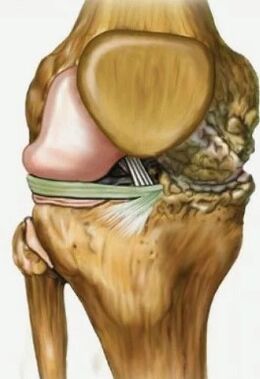
As the disease causes characteristic deformations in the joints, it is called deformed arthrosis of the knee joint, which correctly describes the typical characteristic of the pathology. The disease is chronic and is most often diagnosed in women, overweight and venous pathologies from the lower extremities, but there may be other causes. Due to age -related changes, people also appear in the elderly.
Young arthrosis can be caused by injury. As a result of degenerative-distribution changes, the cartilage softens, delayed and is covered with cracks of various depths. Subsequently, he fails to fulfill his function.
Reasons
Several causes lead to the appearance of deformed arthrosis of the knee joint. A traumatic factor is a common cause of occurrence. Post -traumatic arthrosis can develop due to the receipt of dislocation or fracture in the specified zone, as well as meniscus lesions. Normally, knee joint gonarthrosis appears in young people who are actively involved in the sport or those people whose work is associated with increasing mobility, elevation and weight transfer.
Few people know that this damage may be a consequence of treatment, when the injury itself is already healed, but during the long -term immobilization of the limbs, there were circulatory disorders in this area. Because of this, gonarthrosis appeared.
Increased knee physical effort is one of the main factors in the appearance of the disease. Most of the time, it affects athletes who have constant active charges in the knee. At an early age, arthrosis may not seem, usually rapid changes begin after physical activity.
There is also a risk of disease in people who, even in adulthood, do not reduce joint load. In such athletes, the risk of fractures and displacements increases, microtraums appear. Therefore, after forty years, doctors recommend that athletes reduce cargo, change to coaching work. Running and squats are better excluded, as it is these types of activity that, above all, carry the knee joint. Most of the time, an affected limb occurs and gonarthrosis read on the left or the right -hand gonarthrosis.
The removal of the meniscus becomes an essential factor for the development of knee joint arthrosis. If, for some reason, the menisci have been removed, this in 90 % of cases will lead to the appearance of arthrosis -ocreases the so-called roast knee, during which joints are more friction than usual.
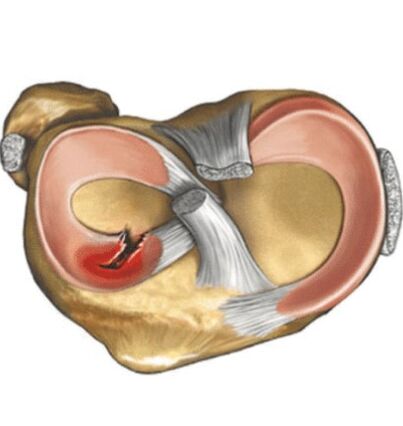
This is the case of Menisci's arthroscopy - a tear - that can become a trigger for knee articulation arthrosis
The problem of overweight is also relevant to people with arthrosis. Excessive body weight creates unnecessary pressure on the joints. As a result, the cartilage itself is damaged, but the meniscus. And with a combination of acute arthrosis and overweight threaten varicose veins of the lower ends.
The weak ligament apparatus in some patients is an innate feature, and sometimes ligaments are affected by other diseases. One way or another, weak ligaments cause greater joint mobility, which is why joint surfaces are significantly abrasion. The consequences of weak ligaments cannot be felt for a long time until patients experience the symptoms of true arthrosis.
Articular pathologies also lead to the development of the disease. Most of the time, arthrosis becomes the guilty of arthrosis - inflammation of joint joints. With arthritis, typical signs are observed - a deterioration in the composition of synovial fluid, pathological changes in cartilage, swelling and redness of soft tissues. Even after osteoarthritis, chronic processes lead to the appearance of arthrosis.
Violations of metabolic processes usually lead to pathologies of the musculoskeletal system. Bones and joints do not receive nutrients and minerals, so it is necessary for the strength of the tissue. With the lack of bone and cartilage surfaces, they are subject to destructive processes, so even with a slight load, appears primary arthrosis.
Symptoms
Knee articulation arthrosis manifests itself by a complex of characteristics difficult not to perceive. There are no signs only in the first degree of development of the pathology, but the second and third degree provides clear symptoms of knee joint arthrosis:
- Pain is one of the main signs, which is not manifested by a rhinestone. It is interesting that, with the development of arthrosis, pain cannot be felt even for several months or years until the disease is aggravated. Normally, the first signs of pain are discomfort in physical effort, walking or running, but also manifests when a meniscus is compressed. In the second degree of arthrosis, joint pain is stronger and, with the third degree of development, painful sensations appear even at rest. The attacks are aggravated even after short walks without a strong joint load, so patients try to save their knees;
- Deformations - Manifestations become increasingly pronounced in the third stage of arthrosis development. The knee will maintain its usual form, but it seems a little swollen, swollen. When arthritis is united, the knee turns red, it will be hot and painfully to the touch;
- Crystal with arthrosis appears in the second and third degree of disease development. Crunchy sounds differ from healthy clicks, which can sometimes be heard when extending and bending the knee. With arthrosis, symptoms are characterized by a rude dry sound, which occurs strongly and is accompanied by pain;
- Synovitis is the accumulation of a certain amount of liquid in the joint cavity. It is also contained there. But the accumulation of an excessive amount leads to the development of a cyst - the baker cyst, which can be determined in the exposed leg position, is more noticeable;
- Limited knee mobility is a typical sign of pathology, as patients first try to protect themselves from consciously pain and, at a late stage of arthrosis, cannot double the limb. In the third degree of development, deformed osteoarthritis of knee joint (DOA) leads to loss of movement. Patients adapt to move on folded legs using support products.
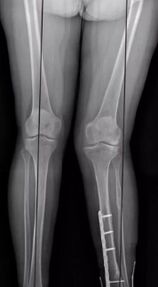
The degree of development
Knee joint arthrosis occurs in the development of three degrees.
With arthrosis of the 1st degree, painful pain and occurs only with active physical effort in the knee joint. In the first extension, the liquid in the cavity can accumulate, which in the second and third is already a cyst. With progression, pain occurs in the movement process, but passes quickly. Externally, knee joint deformation is invisible; Therefore, the diagnosis of knee joint arthrosis can be difficult.
Pain in arthrosis appears even when external signs of the disease are not noticeable
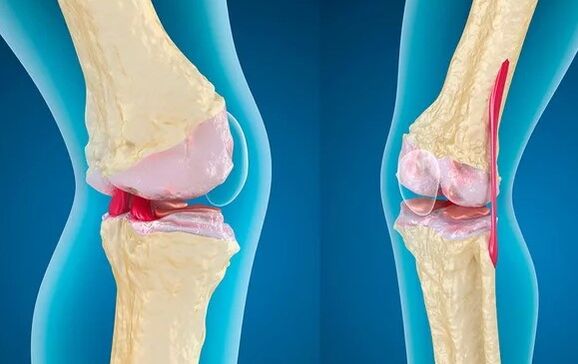
With a second degree disease, cartilage tissue damage is more significant. If you take an X -ray, the bone growth stage is already noticeable. With any movement, the sudden acute pain appears in the knee, but, returning to a convenient position, the knee no longer hurts. In the second stage of Doa, you can hear a typical arthrosis crisis. Upon progressing, problems with knee extension and flexion are aggravated. The deformation becomes noticeable in appearance.
Third -degree knee joint osteoarthritis is characterized by a significant thinning of cartilage. Gradually, the cartilage is so soaked that the bone is exposed in some areas. The x -ray image shows a significant amount of osteophytes - bone growth, salts that appeared in the joint cavity. Externally, changes are clearly visible and the patient is concerned about constant pain. It is easy to make a diagnosis there is enough visual examination and a retire control is performed.
With the progression of this degree, arthrosis can lead to a complete loss of functionality. In any degree of pathology development, knee joint osteoarthritis can enter.
Treatment
Conservative
A group of the most active drugs against arthrosis is non -esteroid anti -inflammatory. These are mainly cyclooxygenase-2 inhibitors, they can relieve inflammation, swelling and contribute to the rapid possible recovery. These medications have significant restrictions, so they cannot be used without the doctor's recommendation. For example, they are capable of aggravating a stomach ulcer, heart disease and urinary organs. Non -esteroid anti -inflammatory drugs are prohibited during pregnancy.
The second background group is the chondroprotectors that improve the characteristics of the cartilage. They are used for arthrosis to restore the correct structure of the cartilage, because in the resolution process loses very important components - chondroitin and glucosamine. Therefore, almost all chondroprotectors have these two substances, but some medications are a component. With the help of these medications, you can help the patient in the first and second stage of disease development, but not in the third, when irreversible changes occurred.
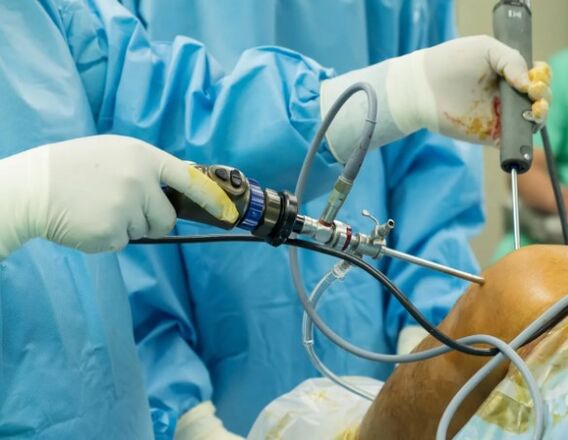
Throughout conservative therapy, the doctor will give nutrition recommendations. If a patient or patient is overweight, it is necessary to adhere to a diet to normalize the weight. How to strengthen stable weight - the doctor will also say. Nor is it recommended to eat a lot of salt, but it is better to fill the diet with calcium, vitamins and minerals. Jelly, jam, will be helpful.
Operational
The most common type of surgical intervention for arthrosis is arthroscopy, but other interventions are performed. The treatment of knee joint arthrosis is usually performed in the second and third degree, when conservative therapy no longer helps.
If necessary, minimally invasive intervention, for example, by accumulating a liquid in the knee joint, it is possible to see with a puncture. In the knee joint cavity, a puncture is made and excess fluid is pumped. This method can be diagnosed with the disease, so it is applied simultaneously for treatment. The liquid is taken at the early stage in a minimum amount, but this already significantly improves the patient's well. Then, after the study of biomaterial, another part is removed and corticosteroids are introduced into the joint cavity.
Endoprosthetic is sometimes the only way out for patients with arthrosis of the third degree
Arthroscopy is more common. Through a small incision, several tools are introduced into the skin, which allow you to perform a joint exam and the necessary manipulations in it. With the help of arthroscopy, you can remove particles from tissue separate from cartilage, but there is always a risk that secondary gonarthrosis will appear.
With serious damage, it is necessary to perform a periosmante osteotomy. This is a greater effect on the joint as a result of which it is slightly fed and installed at the right angle. After the operation, rehab is longer, but the effect lasts longer.
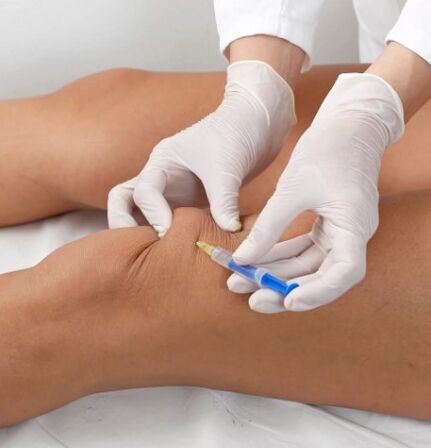
Significant destruction of joint elements leads to the complete immobilization of the limb. The board does not fulfill its function, which means it needs to be replaced and you need to do the operation. The knee joint endoprophetic is an expensive operation, but makes it possible to return the movement to the patient to the limb. Several knee prostheses are installed - plastic, ceramic or metal. These are durable buildings that allow you to forget the problem for several decades.
Physiotherapeutic
Physiotherapy methods can only be used when the acute period is passed and the patient is recovering.
Among the techniques are actively used:
- Ozon therapy is the effect on the affected articulation of ozone, and the substance can be introduced into injection or applied as external treatment. This type of patient care is very effective; Therefore, it is often used to treat various pathologies, including arthrosis. Treatment allows to activate blood circulation in the problem area for an anti -inflammatory and analgesic effect. At the same time, glucocorticoid treatment is performed;
- Kinesiotherapy - The treatment is performed using a special exercise set. The load is formed taking into account individual data and, when performing exercises, special simulators that strengthen the joints are used. The difference between kinesiotherapy and physical therapy exercises in active effects not only in knee osteoarthritis, but also throughout the organism as a whole.
They use not only ozonotherapy and kinesiotherapy, but also physiotherapy exercises. Good results are provided by copyright methods to eliminate knee arthrosis - exercises in Bubnovsky, Evdokimenko, Dikul. Throughout the exercises and after them, we need to use a special kneeira - an orthosis, to strengthen the right or left knee articulation.



















